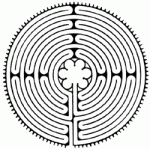An introduction into the world of labyrinths thanks to my good friend, John Ridder:
 Labyrinths are found in many cultures dating back as much as 3,500 years. Unlike a maze, the labyrinth is unicursal, having a single path leading to the center with no loops, cul-de-sacs or forks. They all share the basic features of an entrance or mouth, a single circuitous path and a center or goal.
Labyrinths are found in many cultures dating back as much as 3,500 years. Unlike a maze, the labyrinth is unicursal, having a single path leading to the center with no loops, cul-de-sacs or forks. They all share the basic features of an entrance or mouth, a single circuitous path and a center or goal.
The two most common types of Labyrinths are the Chartres and Classic-7. However, there are many variations, including Custom labyrinths created by modern labyrinth-makers such as the elliptical World Peace Labyrinth. Labyrinths are described by how many concentric circuits or paths they contain. They can measure from a few inches to hundreds of feet wide.
The Chartres, 11-circuit Labyrinth was constructed around 1201 AD in the stone floor of Chartres Cathedral, France. Its distinguishing features are; 11 circuits, the turns arranged in four quadrants, lunations or teeth around the perimeter, and a 6-petal rosette in the center. Medieval Christians visited Chartres (and other cathedrals) and walked the labyrinth as an alternative to taking a hazardous pilgrimage to Jerusalem to walk in the “foot steps of Christ.” Modern “pilgrims” walk the labyrinthine path as one of many tools to enhance prayer, contemplation, meditation, and/or personal growth.
The Classic-7 Labyrinth is a simpler design that is often called the ‘Cretan’ referring to the design found on ancient coins on the Island of Crete. It is also the oldest style found in many cultures as early as 1500 BC. Actual usage theories vary depending on the time and culture. Its distinguishing features are; 7 circuits, an egg-like shape and the turns in the lower part of the labyrinth.
WALKING A LABYRINTH
Many community organizations, churches and retreat centers are making labyrinth walks available for public use for prayer, meditation, contemplation or personal growth. The labyrinth walk is popular with a growing number of people because of it simplicity and the ability to approach its paths on your own terms.
1) Environment: Begin by setting the environment for the experience. At organized walks, your host or facilitator prepares by adjusting lighting, selecting music, controlling air conditioners, and saying opening prayers. Set your personal environment by dropping your ‘physical baggage’ such as key-chains, pocket change, cell-phones, watches and dangling jewelry. We suggest you remove watches to remove the temptation to measure your progress chronologically. On an indoor labyrinth you may be asked to remove you shoes and walk in your socks. Outdoors, enjoy the sounds of nature; experience a barefoot walk on a grass or stone labyrinth!
The Walk: There is not a “required way” to walk the labyrinth. The beauty of the labyrinth is that people can approach the experience on their own terms. However, as a guideline, we can break the ‘walk’ down into these stages.
2) Entering: (also referred to as shedding or purgation.) During this stage you walk the path toward the center, and should try to acquire a relaxed, peaceful state, temporarily releaseconcerns and quiet the mind.
3) Illumination: The time in the center. This is a time of openness and peacefulness; you experience, learn or receive what this unique moment offers. Take your time.
4) Union: The journey outward. You choose when to leave the center, following the same path. This is a time to review and consider what occurred in the center and how it may be applied in your life.
5) Implementation: This stage represents your life outside the labyrinth; the world where your experience or illumination is carried into and affects your everyday life.
Other approaches to the walk may include:
Intentional walks: where you address a specific intention, issue or concern as you walk.
Intercessory walks: offer prayer for people or needs. Perhaps praying for a different person at each turn on the path.
Meditative walks: meditate on a specific word or passage, or pray repetitively, such as the Jesus prayer (Lord have mercy…) or the universal prayer for world peace. (Let peace Prevail on Earth!)
